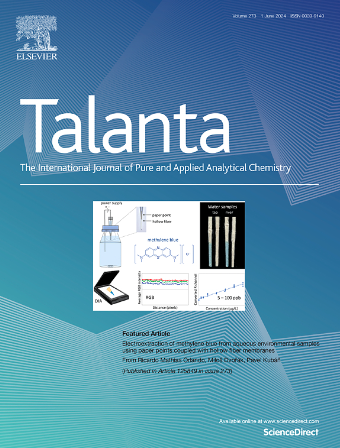Magnesium-based micromotors for electrochemical detection of dopamine in blood
IF 5.6
1区 化学
Q1 CHEMISTRY, ANALYTICAL
引用次数: 0
Abstract
In the fields of neuroscience and medicine, the accurate capture and quantitative analysis of dopamine (DA) levels in the blood are of great clinical significance for the early diagnosis of neurological dysfunctions and other pathological conditions. In this study, we developed a laccase (La) sensor based on micromotor technology to accurately detect DA content in blood. Firstly, the magnesium-based micromotor was used to endow the sensor with autonomous motion performance, which significantly increased the contact frequency between La and DA molecules in blood. Secondly, the micromotor-loaded Fe3O4/PPY/La magnetic nanoparticles provide an efficient electrical signal transmission interface for La, while the presence of polypyrrole (PPY) prevented electrode passivation caused by La. In addition, we used magnetic to collect Fe3O4/PPY/La after capture and tested it by differential pulse voltammetry. Finally, thanks to the excellent catalytic performance and high selectivity of La, the effective recognition and detection of DA in blood samples were realized, and an efficient electrochemical detection method was developed. This innovative detection scheme has a wide linear detection range and high sensitivity, which is expected to provide a more accurate diagnostic tool for health problems related to DA abnormalities, so as to better cope with and prevent related diseases.

求助全文
约1分钟内获得全文
求助全文
来源期刊

Talanta
化学-分析化学
CiteScore
12.30
自引率
4.90%
发文量
861
审稿时长
29 days
期刊介绍:
Talanta provides a forum for the publication of original research papers, short communications, and critical reviews in all branches of pure and applied analytical chemistry. Papers are evaluated based on established guidelines, including the fundamental nature of the study, scientific novelty, substantial improvement or advantage over existing technology or methods, and demonstrated analytical applicability. Original research papers on fundamental studies, and on novel sensor and instrumentation developments, are encouraged. Novel or improved applications in areas such as clinical and biological chemistry, environmental analysis, geochemistry, materials science and engineering, and analytical platforms for omics development are welcome.
Analytical performance of methods should be determined, including interference and matrix effects, and methods should be validated by comparison with a standard method, or analysis of a certified reference material. Simple spiking recoveries may not be sufficient. The developed method should especially comprise information on selectivity, sensitivity, detection limits, accuracy, and reliability. However, applying official validation or robustness studies to a routine method or technique does not necessarily constitute novelty. Proper statistical treatment of the data should be provided. Relevant literature should be cited, including related publications by the authors, and authors should discuss how their proposed methodology compares with previously reported methods.
 求助内容:
求助内容: 应助结果提醒方式:
应助结果提醒方式:


